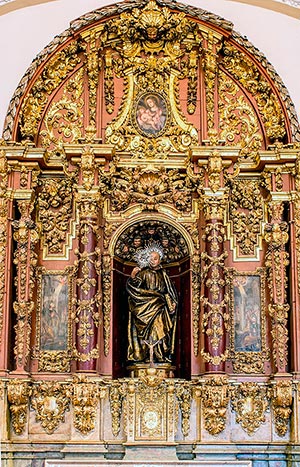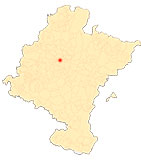Basilica of St. Ignatius of Loyola
By Ricardo Fernández Gracia
|
|
|
|
|
|
|
|
|
|
|
|
|
|
|
|
|
|
|
|
|
|
|
|
|
|
|
|
|
|
|
|
|
|
|
The new altarpiece and its frontal
A little later, around 1726-1727, the altarpiece was made, which stands out for its decorative style and its supports: stipes, so rarely used in the Pamplona workshop, and the plain shafted columns with garlands which, at that time, were making their way into the Navarrese altarpiece. The titular image is of great quality. The saint appears in cassock and mantle, holding the Constitutions of the Society, and the sun, which reminds us of what the saint wrote in his Autobiography: "He saw Christ as the sun, especially when he was dealing with important things". The sculpture dates from the third decade of the 17th century and undoubtedly comes from Valladolid, from where the Jesuits brought various images to their Pamplona site high school . It follows the subject of the sculptor Gregorio Fernández and is a copy of the one that the aforementioned sculptor made in 1614 for the high school de Vergara.
As for the author, we should not lose sight of one of the most famous workshops in Pamplona in those decades of the 18th century: the workshop of José Coral, a Valencian artist established in the capital of Navarre from 1717 until his death in 1753 and author of the major altarpieces of Huarte Araquil and Ciáurriz and of the Rosario de Larraga.
As for the promoter, we should remember the Duke of Granada de Ega and Count of Javier, Don Antonio de Idiáquez, who undertook the renovation of his churches at board of trustees in the first half of the 18th century with the creation of several altarpieces. He also did so in the abbey of Javier and in the altarpieces of the chapels of Santo Cristo de los Milagros in the Merced in Pamplona (1750) and of San Pedro Mártir in the Dominicans in the same city (1743-1750). The latter two altarpieces were commissioned by the Duke from the aforementioned José Coral in 1750. There is no doubt that the nobleman wished to project his image in all those religious spaces, making clear his signs of munificence and his devotions. Although the board of trustees of the basilica did not correspond to him, he did favour the cult of the saint as much as he could and endowed the feast of the saint's fall, years later, in 1754.
The frontal is exceptional in Navarre. It was made in 1755 by the masters who worked on the sanctuary of Loyola, with jasper and inlays from Genoa and Villabona. It cost 1,408 reales. It is one of the few works of inlaid marble, together with the frontal of Santa Ana in Tudela and the disappeared mausoleum of the Marquis of Castelfuerte in the Dominicans of Pamplona, the latter by Juan Bautista Eizmendi.
file Diocesan of Pamplona. Government of the Diocese. administrative office de Cámara. Boxes 293, 294, 295, 296 and 297.
ASCUNCE, E., Íñigo de Loyola, capitán español, y el castillo de Pamplona, Madrid, Aguado, 1939.
AZANZA LÓPEZ, J., La arquitectura religiosa del Barroco en Navarra, Pamplona, Government of Navarre, 1998.
EGUILLOR, J. R., Loyola, historia y arquitectura, San Sebastián, Etor, 1991.
FERNÁNDEZ GRACIA, R., El retablo barroco en Navarra, Pamplona, Government of Navarre, 2003.
FERNÁNDEZ GRACIA, R., "The Jesuits in Pamplona 1580-1767". Diario de Navarra, 28 April 2014, pp. 70-71.
FERNÁNDEZ GRACIA, R., "Heritage and identity (52). The basilica of San Ignacio in Pamplona". Diario de Navarra, 21 May 2021, pp. 62-63.
GARCÍA GAÍNZA, M.ª C. et al., Catalog Monumental de Navarra V. Merindad de Pamplona ***, Pamplona, Institución Príncipe de Viana, 1997.















